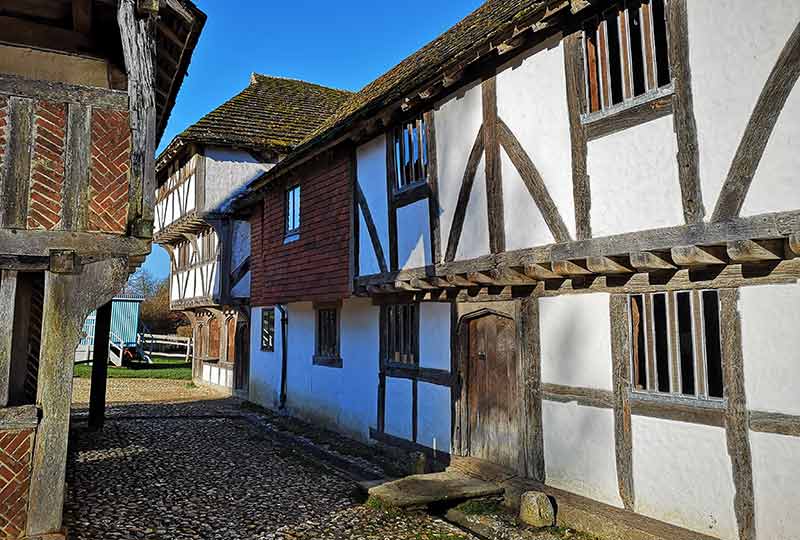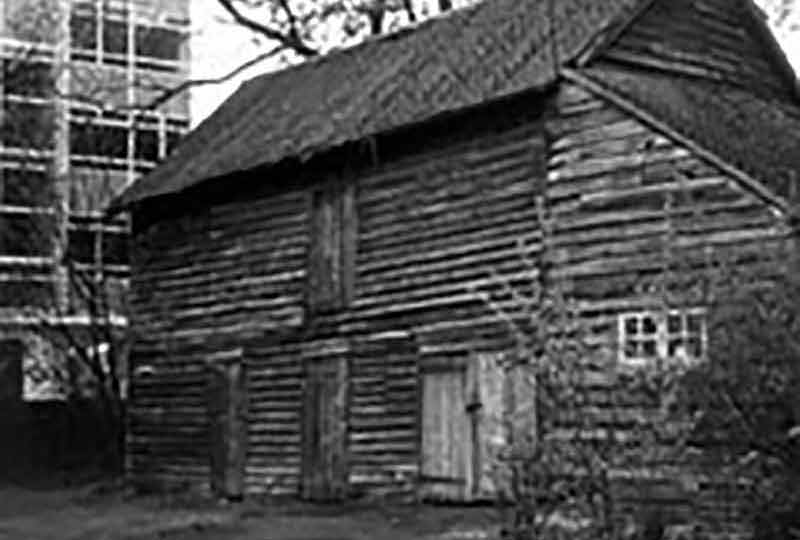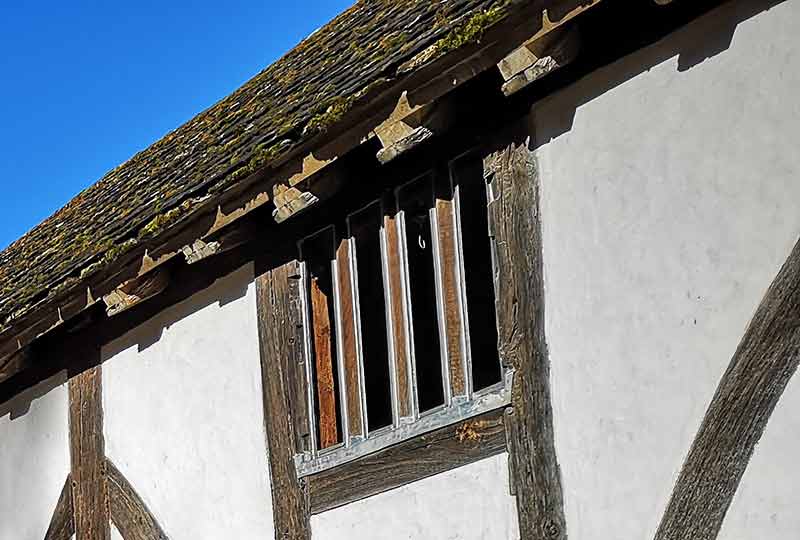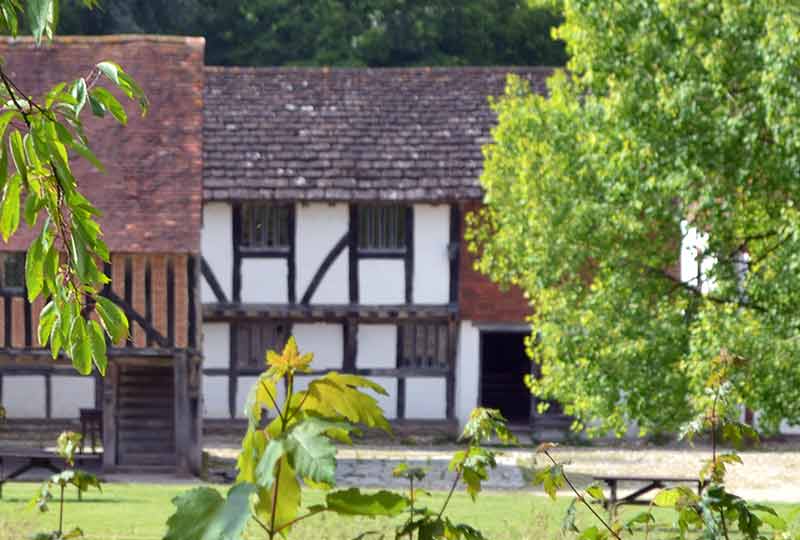
The original site of this building was in Crawley, to the rear of a house on the east side of the old High Street. It had long been known locally as ‘the old barn’ and served as a store shed.
After the Crawley New Town Commission had decided to demolish it, detailed examination showed that it had originally been a much longer building, jettied on one side. The upper floor had formed a long hall which may have served as a meeting place for some public purpose. The ground floor was partitioned between the bays and these rooms may have served as stores or shops.
An alternative possibility is that the building may have formed part of an inn, reflecting the importance of Crawley’s site on the junction of east-west and north-south routes.
Share
Overview
Dismantled
1972
Reconstructed
1978
Original Location
Crawley, Sussex
Building History
Background Information
The original building was at least five bays long, but had been shortened at both ends. The three surviving bays have been restored as nearly as possible to their original form, but in order to make the building usable the windows have been glazed — originally they were unglazed, like all the other medieval windows at the Museum. The doorhead in the front wall is based on a surviving example in Crawley High Street.

The upper hall from Crawley on its original site. It had been converted into a barn.
The roofs of this building and the Horsham shop are covered with Horsham slabs. This heavy laminated sandstone is found only in the Weald clay and was once quarried extensively both to the south and the north of Horsham.
Within the triangle formed roughly by Horsham, Crawley, and Steyning, most buildings with any pretensions to a sturdy structure and a long life appear to have been roofed with this stone, including even small farm buildings such as granaries.

At each end of the exhibit a bay has been constructed in modern materials to replace the missing original ends. The ground floor houses the Museum’s library, and the upper hall is used as a meeting room, so these areas are closed to the general public.
Article: The Fittleworth Painted Panels
The Fittleworth Painted Panels by Danae Tankard
In the entrance lobby of the hall are four painted panels which were removed from the upper room of Ivy House in Fittleworth in 1968. The elaborate black-on-white floral, foliate and abstract designs, thought to date to around 1580-1600, were discovered whilst the house was undergoing renovation to remove a bulging infill between the framing timbers.
This turned out to be a layer of reed plaster that had been used to cover up the wall paintings, probably in the 18th century. The new plaster was supported on battens, creating a protective air space for the original painted plaster.

Fittleworth panels in situ.
As is typical of schemes like this the decoration continued across the timbers without interruption. Surviving painting on the timber framing showed that the scheme had initially covered all four walls although that on two of the walls had been destroyed at an earlier date when the wattle and daub panelling was replaced.
The painted scheme on either side of the front facing window included two wreathed roundels. The inner space of one was blank but the other contained a partly-completed heraldic shield. On this there were faint remnants of yellow and red colour.
The person who more than anyone else was responsible for recognising the significance of the wall paintings and for ensuring their survival was Marjorie Hallam, a key figure in the early history of the museum and one of the founders of the Wealden Buildings Study Group. Marjorie also undertook the initial research on the wall paintings.
Building Preservation
Ivy House was a listed building and the owner had sought, and been given, permission to renovate by the local authority. The wall paintings had not been visible at the time permission was given. Once they had been discovered the authority should have been notified.
However, the owner had already begun to knock out the painted panels by the time the Wealden Buildings Study Group and the Museum were alerted to their discovery and the most that they could do was to persuade him to delay his building works until a detailed photographic record of them could be taken, prior to their removal.
The owner, intent on their destruction so that he could complete his renovations, agreed that the newly-founded museum could take them. As Armstrong said in a letter of May 1969, “I think it is fair to say that but for our action there would today be no more trace of this historical and artistic find…”
The wall panels were conserved by the South Eastern Area Museum Service laboratories and displayed initially in Hambrook Barn (as part of the Museum’s introductory exhibition, which won the National Heritage Museum of the Year Award in 1975) before being moved to their current location in the lobby of the hall from Crawley.
Ivy House
A building survey undertaken by Annabelle Hughes in 1993 revealed that Ivy House started life as a late medieval open-hall house, like Bayleaf farmhouse, consisting of a two-bay hall, with a chamber at the upper (southern) end and a service room (or rooms) at the lower (northern) end. The house underwent substantial modifications in the 16th century. The open hall was floored over and a chimney stack was inserted at the lower end providing a ground floor and possibly two first-floor hearths.
Ceilings were put into the first floor rooms. The orientation of living space would have changed at this point, with the ‘best’ rooms in what had formerly been the lower end. There was an access stair at the southern end of the house, which probably provided the only first-floor access, with passage from room to room.

Ivy House in 1968.
Subsequently a face or cross wing was added at the northern end of the house with an eastern-facing jetty and an external chimney stack serving two hearths. An east-facing staircase tower was added providing separate access at this end. The style of timber framing, in particular the distinctive ogee braces, suggests that the cross wing was built between 1580 and 1600 which is consistent with the dating of the wall paintings.
The house was extended towards the south in the 18th century and to the front in the late 18th or early 19th centuries. Unfortunately it has not been possible to find out for certain who was living in Ivy House at the time the wall paintings were executed. We know that it was a copyhold property held of the manor of Bury which was part of the estates of the Dukes of Norfolk. The earliest clear reference to it in manorial records is in 1673 when John and Frances Peckham transferred the copyhold to John Gibson.
At this date it was described as a “messuage or tenement, barn, stables with garden and orchard… situated… in Fittleworth within the tithing of Sonde” (the manor was divided into four tithings: Bury, West Burton, Sonde or Sand and Hurst). Frances had inherited the property from her father, John Stanley, who died in 1660. He may have been resident in the house when he signed the Oath of Protestation in 1641. John Peckham and John Stanley are described in contemporary records as gentlemen; in other words, they were members of the minor or lower gentry.
There is a gap in the manorial records between 1619 and 1672 and when we look at those covering the years 1583 to 1607 it is not clear which property is ours. Someone living in the area who is of the right status is Richard Hardam senior who died in 1604: like Stanley and Peckham he is described as a gentleman. His death was recorded in the manorial court in 1605 at which time his property was described as “a cottage or tenement lying in Fittleworth… and also a barn.”
It was inherited by his son, Richard Hardam junior. Like the copyhold property described above, this one lay within the tithing of Sonde, but it is unlikely that Ivy House would have been described as a ‘cottage’ even before it was extended. Hardam junior was an attorney in the Court of Common Pleas, a common law court dealing with civil cases, mainly debt and property, which sat in Westminster Hall. In this role he would have divided his time between Westminster and Fittleworth.
The Heraldic Shield
In his will of 1604 Richard Hardam senior bequeathed to his son “my lute, my luting books, my book of armoury and all… other my books.” The reference to the ‘book of armoury’ is intriguing given the heraldic shield that features in the Fittleworth paintings.
Which ‘book of armoury’ Hardam owned is unknown but it may have been Gerard Leigh’s popular The Accedens of Armory, first printed in 1562 and reprinted five times between 1568 and 1612. The Fittleworth shield is unfinished since it lacks heraldic signs and was probably generic or fictional (i.e. it was not intended to represent an actual coat of arms).
It is likely that its function was intended to be decorative. Alternatively or additionally the householder may have thought that it would enhance his status; in that sense, it could be described as aspirational.

Fittleworth panels heraldic shield.
The choice of colours may have been purely decorative but it may also have been symbolic. The complex symbolism of heraldic colour is explained by Leigh. So for example ‘gules’ or red was ‘a royal colour and has that proper quality in itself that it may not be gazed on any while for then the eye is weakened thereby’.
Its associated planet was Mars which ‘betokens strength, boldness, with hardiness’ and its associated precious stone was the ruby. ‘Or’, gold, or yellow symbolised prowess and virtue; its associated planet was the sun, the worthiest of all planets, and its precious stone was the topaz. The symbolism of these colours changed when they were combined together so ‘gules’ combined with ‘or’ signified ‘a desire to conquer’. The pigments used to achieve these colours would have been red and yellow ochre.
The Black-on-White Design
The heraldic shield is a small part of a complex and highly sophisticated scheme created using carbon black and chalk white. The scheme was not uniform across the whole room, but used a variety of patterns which were repeated in approximately similar arrangements on each wall.
The wall plate was decorated with a chevron design. Below this was a broad horizontal band of a naturalistic floral and foliate design, followed by alternating vertical bands of more abstract, curvilinear decoration. Different schemes were used for the intervening timbers of the wall frame.
The Floral and foliate design bears some resemblance to the scheme found in the upper room of the house extension from Reigate which is of course coloured rather than black and white and thought to date from about 1620.
Both schemes have much in common with contemporary embroidery patterns. The Fittleworth scheme in particular is similar to so-called ‘black work’, a style of embroidery popular in England in the late 16th and early 17th centuries found on women’s headwear (coifs and forehead cloths), stomachers and waistcoats.
Designs were either hand drawn with pen and ink or block-printed onto linen cloth before being embroidered in black thread. These designs were influenced by printed herbals such as Gerard’s Herbal of 1597 and other popular books about the natural world. They could also be copied from embroidery manuals such as Richard Shorleyker’s, A ScholeHouse for the Needle, first published in 1624.
The Museum has an example of black work in its collection, a clothing fragment, most likely part of a sleeve, which was found hidden in the eaves of the house extension from Reigate during its dismantling. The elaborate floral design is worked in black silk and silver and silver gilt thread onto a linen background. The piece is thought to date from about 1580.
A Room to be Seen
Like the Reigate scheme, the Fittleworth paintings were in an upper chamber. Their opulence suggests that the room had a public function alongside its private one. The wall paintings were clearly meant to be seen and no doubt favoured guests would have been invited up there where they might have sat in an armchair and drunk a glass of wine with the householder and his wife.
Perhaps they were offered a sugar candy or an orange, luxury food items that were being imported into London at this time. It is a shame that we do not know who was living in Ivy House at the end of the 16th century. Although probably living elsewhere, the Hardams are the sort of people who we would expect to be occupying a house like this – minor gentry, literate with strong London connections.
Socially aspirational, they would have enjoyed showing off their new cross wing with its fashionable wall paintings to their friends and neighbours. The removal of the painted wall panels from Ivy House nearly 50 years ago meant, of course, that their context was lost.
Even with the accompanying photographic record it is difficult to understand the complete scheme. But Armstrong was no doubt right in his insistence that the prompt action of the museum and the Wealden Buildings Study Group prevented their complete destruction.
In a letter on the subject to the local authority in May 1969, Armstrong stated what has always been the core principle of the Museum’s collections policy: that it will not accept any building or artefact that could possibly remain in situ.
With thanks to Eddie Booth, Annabelle Hughes, Anthony Poole and Christopher Whittick.
Top 3 Interesting Facts

Founder’s Inspiration
Bonfires of historic timber-frames in Crawley compelled Roy Armstrong and others to start this Museum and save this and other buildings.

Horsham Slab
The distinctive roof covering is Horsham slab, a heavy laminated sandstone found only in Weald clay and quarried near Horsham.

A Meeting Place
The long upper hall may have been a meeting place and the downstairs rooms stores or shops, or possibly an inn.







